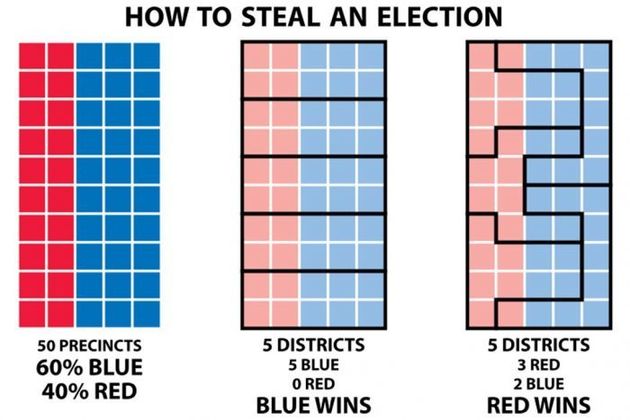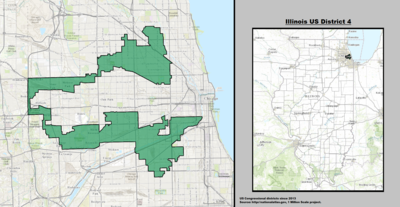One of the worst political issues that only seems to matter during election season is the long-practiced and corrupt art of political gerrymandering. Gerrymandering is a term used to describe the unfair use of political office to redraw congressional districts in favor of one party or another. This restructuring is done in such a way that certain votes end up having more weight and value than others just due to where the voters live, even if the voters live in the same state. This can be best portrayed by the image below:

Gerrymandering is a pressing issue that is abused by politicians, capable of drastically undermining the validity of elections. While gerrymandering itself is not considered explicitly unconstitutional, it still captures the extent at which parties act to gain ground against the other.
As gerrymandering has come into the lime light, many people -including politicians- are going so far as to call it the “greatest threat to our democracy.” In spite of this, little is being done about this issue as politicians continue its back and forth nature, even escalating the practice to levels one would never think possible under government review such as the infamous headphone district in Illinois that is an indisputable product of political gerrymandering.

The district depicted above perfectly captures just how convoluted and unnecessary the shape of certain districts are. There is no reason as to why lines aren’t drawn in a simpler, straighter manner other than political gain. The sharp, sporadic shape of the district is designed to encapsulate a certain population of voters do dilute the potency of their votes in congress. This dilution can be more easily seen when in 2014, 44% of Pennsylvanian voters voted democratic, yet democrats only won 5 of the 18 districts. This clip from Last Week Tonight with John Oliver thoroughly explores this concept.
Now while I’ve said plenty about how gerrymandering works and why it happens, the ‘who’ side of this question has always been unclear. As it turns out, both parties are responsible for gerrymandering regardless of their claims. Politics aside, it is a constitutional duty for politicians to redistrict congressional districts in order to get even population representation and keep up with the changing of times. This massive responsibility falls into the hands of both democrats and republicans, both of whom milk it for all its worth to ensure their success in future elections.
Gerrymandering is an indisputably terrible occurrence that hurts the American democracy, and I would go so far as to liken its effects to those of the electoral college on political elections. They both impose ideas from an outdated age that causes the constitution to fall weak in the modern day. The electoral college too is responsible for misrepresenting the will of the people in the popular vote, just as gerrymandering is used to blur the lines of congressional representation.
So long as we rely on our 2 party system (which likely isn’t going anywhere), the constitution will continue to be tarnished by those seeking political gain. This desire to beat out the competition in politics is one ingrained in every politician and voter, making an arbitrary decision seemingly impossible. I am heavily invested in just how bad party-based decision making can cause misrepresentation in judicial positions, but that is a post for another time.
Personally, I look forward to a day when we no longer look to the constitution as devout Christians do the Bible. While the ideas and intentions may be candid, modern innovations such as computer software have opened up exploits in the constitution that end up hurting the whole. Gerrymandering is only just one of such things
In high school, we learned a lot about gerrymandering in our history classes and how much of an impact it can have on an election. Pennsylvania was one of the worst cases of gerrymandering until it was finally fixed by Congress. I enjoyed the image you chose because I thought it was a great representation of what gerrymandering is and how so many politicians rely on it to win their election. I also liked how you included a clip of John Oliver (one of my favorite comedians) because it added a new element to your blog but was still very informative. Personally, I thought your take on the Constitution at the very end was quite interesting. I agree with you, in the sense that we as Americans rely so much on the Constitution to guide the country. But should we? I guess it’s easier said than done. The Constitution is so deep-rooted into American values that switching it or revising it would be incredibly difficult. I actually came across this article that says how many Americans want to see change in the Constitution, and it explains how things then don’t apply to circumstances now. I think it would be interesting if you talked about a completely new America and what that would look like. For instance, no electoral college, revised or no Constitution, etc. I think that would be a fun and neat blog to write about. Or, you could compare the US’s political world to other countries’ and see the differences. I know many European countries didn’t adopt the Democratic way for a reason-you could maybe delve into that. Just some food for thought, but I’m interested to see where else you take this!
My experience with the system of gerrymandering goes back to my time in high school. I learned about it through a game that I actually went back and found (her is the link: http://www.redistrictinggame.org). In this game, you act as the House of Representatives and work to redistrict the population so that your party comes out on top. I think that your blog post does a great job of explaining how gerrymandering works and why it is a problem for the American people. This whole process actually reminds me a lot of one of the most horrible forms of segregation: redlining. Essentially, after the Great Depression, the housing market started looking into ways to encourage investments. What this involved was looking into the different neighborhood and labelling them for their security. In the end, it was just another form of segregation. To our this in perspective, certain neighborhoods were deemed insecure and labeled as “Infiltration of: negroes.” They divided the zones based on color and denied those that were majority African American neighborhoods basic federal services. While this is slightly different from gerrymandering, the basic concept is still the same: separating people in a way that results in personal or political gain. The gerrymandering system is clearly an abuse of power but is used as a loophole anyway. Drawing lines of districts based on where people are is very clearly shady and getting near dangerous territory such as segregation and discrimination.